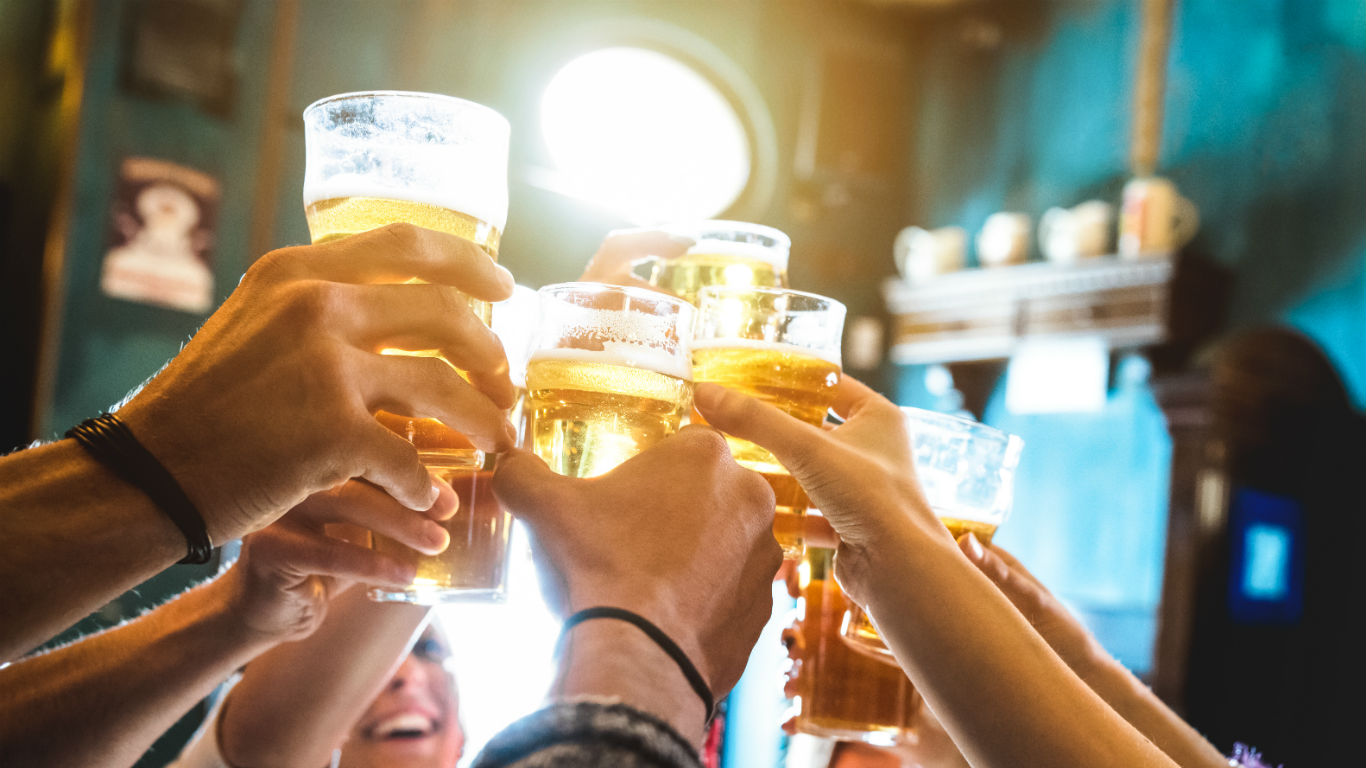
It’s no secret that Americans love beer. Some 42% of those who drink alcohol name beer as their favorite tipple, according to a Gallup poll, while only 34% opt for wine.
We are not, however, close to being the thirstiest consumers of suds. That honor goes to the Czech Republic, whose citizens — in 2017, the last year for which figures are available — downed some 137.38 liters (just over 36 gallons) of beer per capita, according to Statista. We’re way down in 12th place worldwide, managing a mere 74.90 liters (not quite 20 gallons) of beer — slightly less than Latvia, Slovenia, Romania, or Bulgaria, though perhaps surprisingly, almost a gallon more than Australia.
24/7 Wall St. reviewed domestic shipping volume data provided by industry advocacy group Beer Marketer’s Insights to identify America’s biggest beer brands.
And while craft beer sales are growing — they were up 4.7% last year over 2017, according to IWSR Drinks Market Analysis report — the market for big commercial brands (the kinds of beer that appear on this list) actually declined 1.5% over the same period. In fact, 19 of the 31 beers ranked here lost traction between 2013 and 2018.
Whatever the reason, it probably wasn’t economic. Beer is actually cheaper now than it used to be. When 24/7 Wall St. recently researched the price of a six-pack every year between 1954 and 2014, we found that in inflation-adjusted dollars, a six-pack cost $11.67 65 years ago, and only $8.88 in 2014.
Mass-market brews aren’t going anywhere soon, however. Last year, the U.S. beer industry shipped 202.2 million barrels, enough to fill more than 2.8 billion cases of 24 12-ounce cans or bottles, according to America’s Beer Distributors. And 82% of the beer we drank was produced domestically. Only eight of the country’s biggest beer brands were imported.
Click here for the 31 biggest beer brands in America.
As a look at this list will reveal, the majority of the country’s best-selling beers — 22 of them — are produced by just two companies, MillerCoors and Anheuser-Busch InBev. It’s also obvious from this ranking that we love light (or “lite”) beer. Roughly a third of the brews listed here fall under that category, including the top three best-sellers. We’re obviously a health-conscious people.
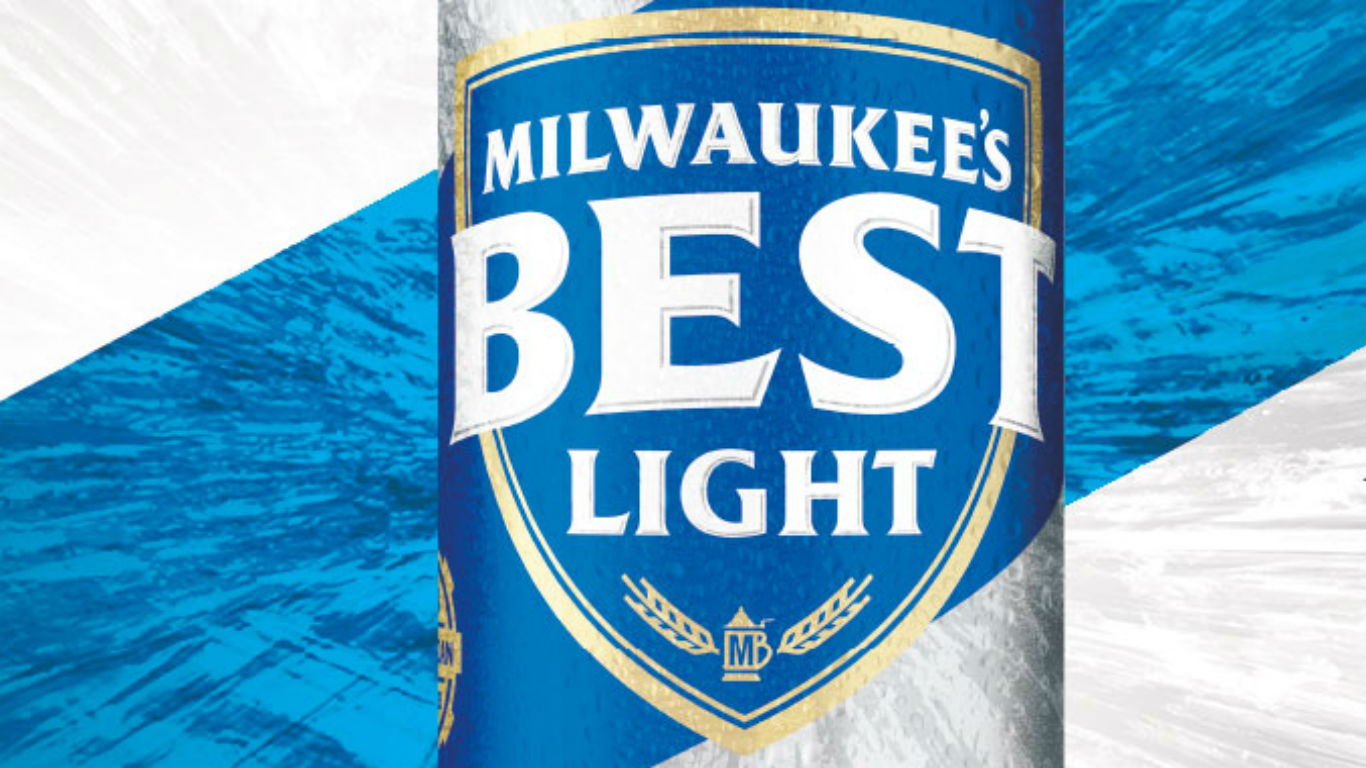
31. Milwaukee’s Best Light
> Parent company: MillerCoors
> Barrels shipped in 2018: 535,000
> Change from 2013: -47.0%
> 2018 market share: 0.3%
Though this light beer was introduced only in 1986, the original Milwaukee’s Best dates from 1895 — though for decades it was available only around its namesake city. Though light brews are not typically favored by serious beer drinkers, this one took home a silver medal in the American-Style Light Lager category at the Great American Beer Festival in 2006.
[in-text-ad]
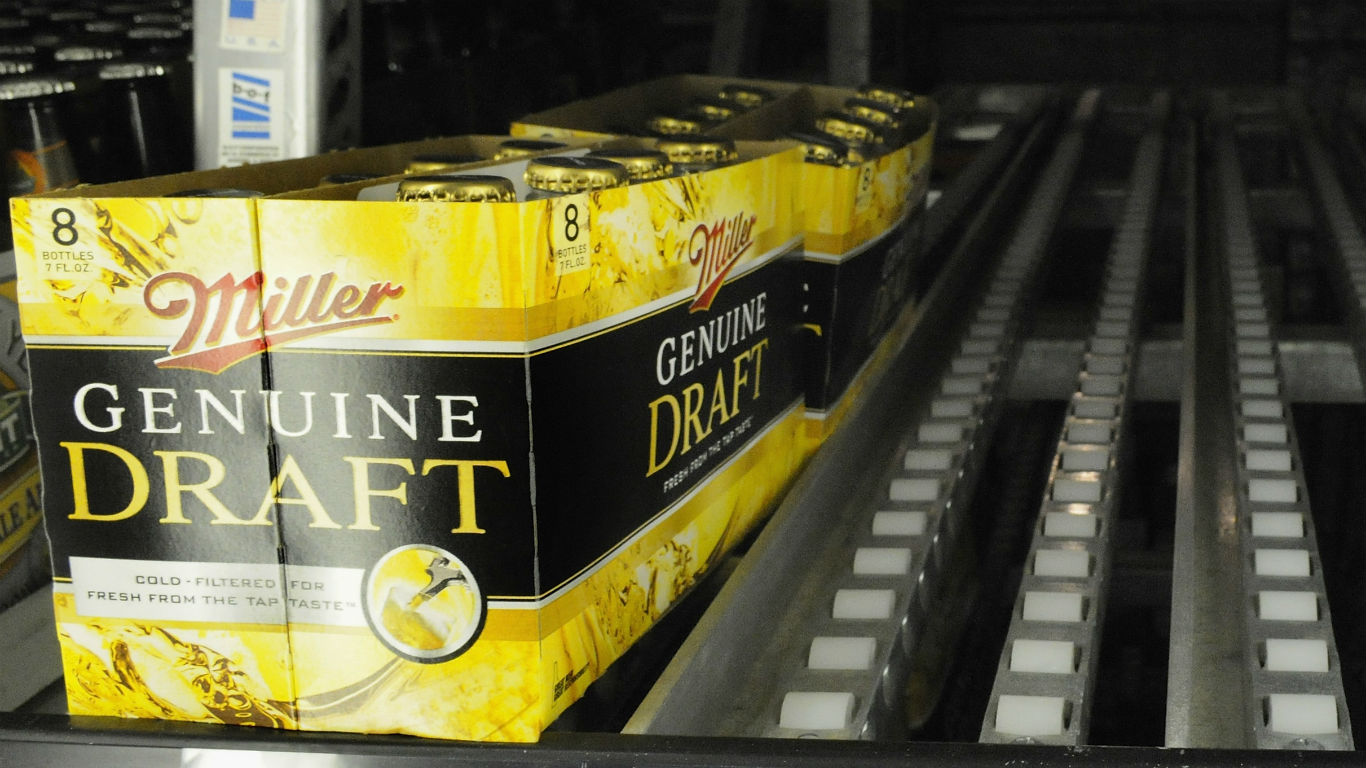
30. Miller Genuine Draft
> Parent company: MillerCoors
> Barrels shipped in 2018: 550,000
> Change from 2013: -52.6%
> 2018 market share: 0.3%
The original brewing facility for this beer, which has been fading in popularity in recent years as shipments tumbled over 50% since 2013, closed down in 2015. This cold-filtered lager is still produced, however, leaving alive the question of how a “draft” beer can be sold in bottles and cans.

29. Tecate
> Parent company: Heineken International
> Barrels shipped in 2018: 680,000
> Change from 2013: -34.6%
> 2018 market share: 0.3%
This popular Mexican beer, a pale lager in style, is brewed by the Heineken-owned Cervecería Cuauhtémoc-Moctezuma. It is commonly served with a wedge of lime, to be squeezed into the pull-tab opening. Despite the near 35% decline in shipments since 2013, the beer remains one of American’s best sellers.

28. Bud Light Lime
> Parent company: Anheuser-Busch InBev
> Barrels shipped in 2018: 700,000
> Change from 2013: -42.9%
> 2018 market share: 0.3%
While beers like Tecate might be consumed with a squeeze of lime juice, this America light lager comes with the lime flavoring already added. At least one reviewer, on RateBeer, finds the lime synthetic-tasting “like they added Mountain Dew…” This might explain the beer’s over 40% volume decline since 2013.
[in-text-ad-2]
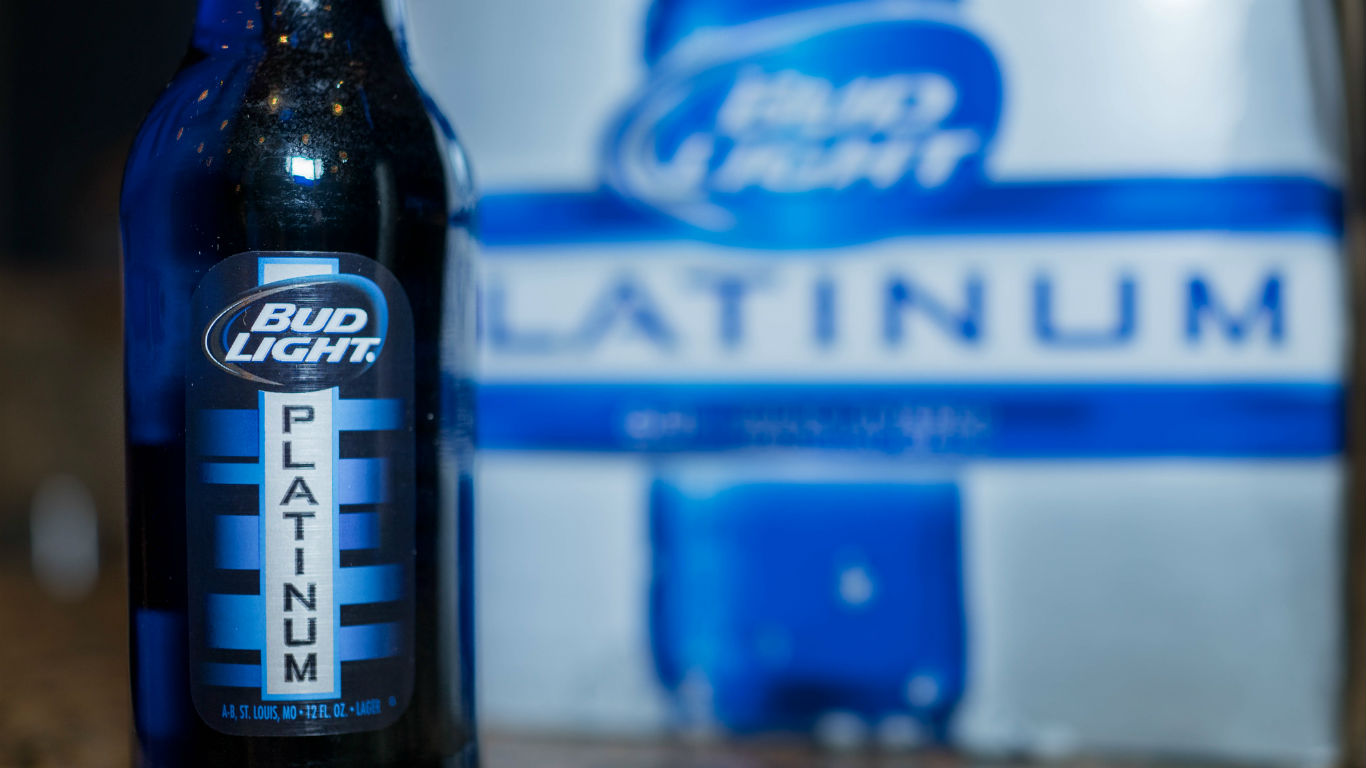
27. Bud Light Platinum
> Parent company: Anheuser-Busch InBev
> Barrels shipped in 2018: 725,000
> Change from 2013: -49.1%
> 2018 market share: 0.4%
With its distinctive cobalt-blue bottle, this potent (6% ABV) malt liquor is triple-filtered for smoothness. Reviewers tend to find it easily drinkable, though its shipments have fallen almost 50% since 2013.

26. Milwaukee’s Best Ice
> Parent company: MillerCoors
> Barrels shipped in 2018: 1,110,000
> Change from 2013: -21.0%
> 2018 market share: 0.5%
Ice beers, chilled below freezing as they’re brewed, are supposed to be smoother than other beers, and they’re definitely slightly higher in alcohol — 5.9% in this case.
[in-text-ad]
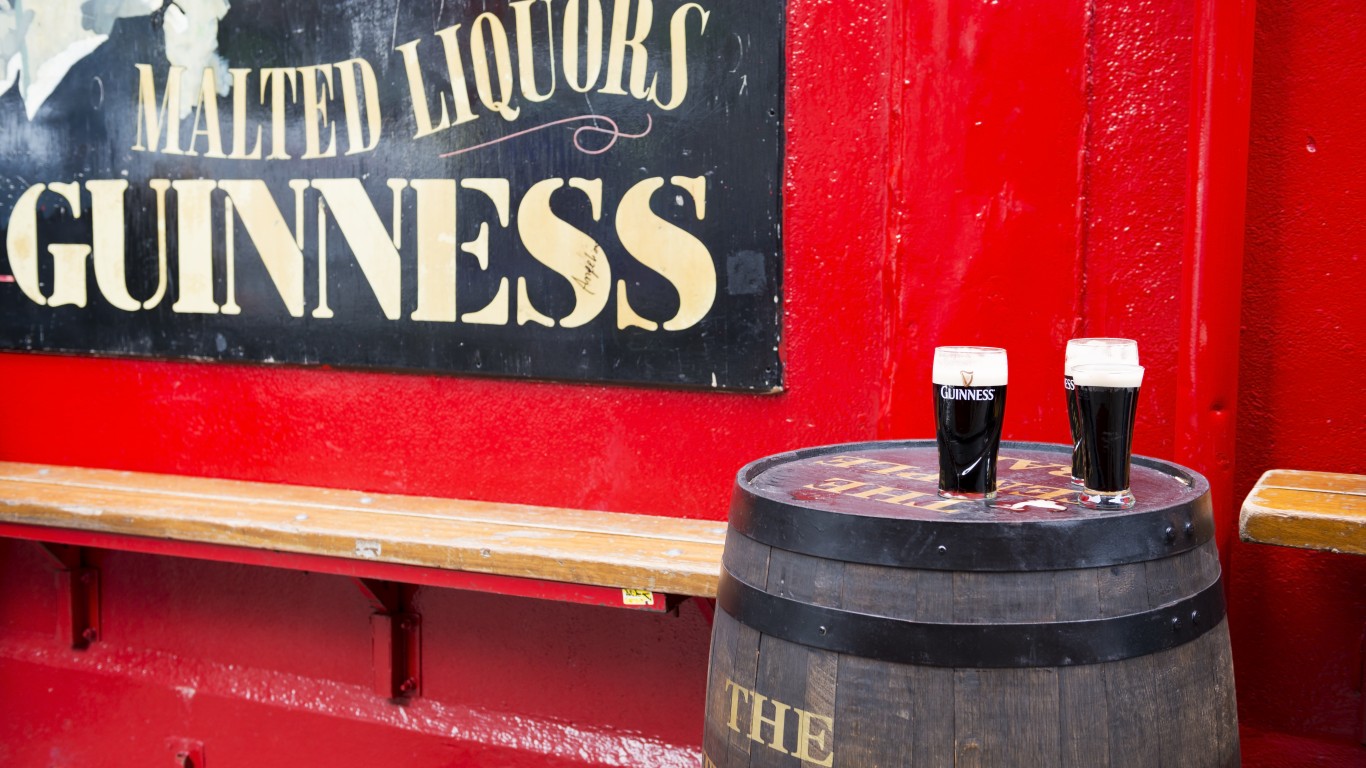
25. Guinness (all)
> Parent company: Diageo
> Barrels shipped in 2018: 1,110,000
> Change from 2013: 6.7%
> 2018 market share: 0.5%
The vast majority of America’s favorite beers are American-made or imported from Mexico, but this iconic Irish brand is an exception. Though the brewery now markets a number of different beers, its rich, dark, original stout is what made its reputation.
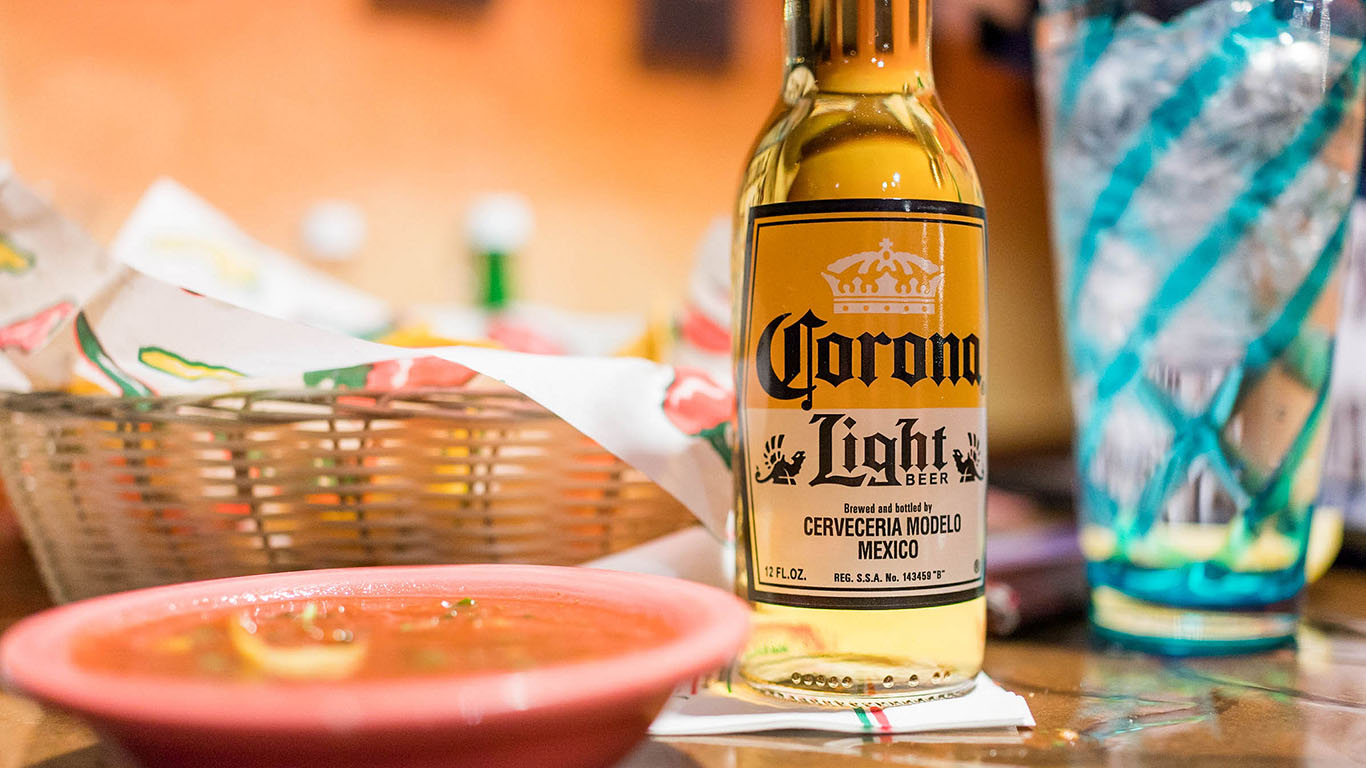
24. Corona Light
> Parent company: Grupo Modelo (Constellation Brands)
> Barrels shipped in 2018: 1,125,000
> Change from 2013: 11.4%
> 2018 market share: 0.5%
Corona Extra is the most popular Mexican beer in America, but this lower-calorie alternative (it has 99 calories per 12-ounce bottle, versus 149 for the Extra) is rapidly gaining fans.
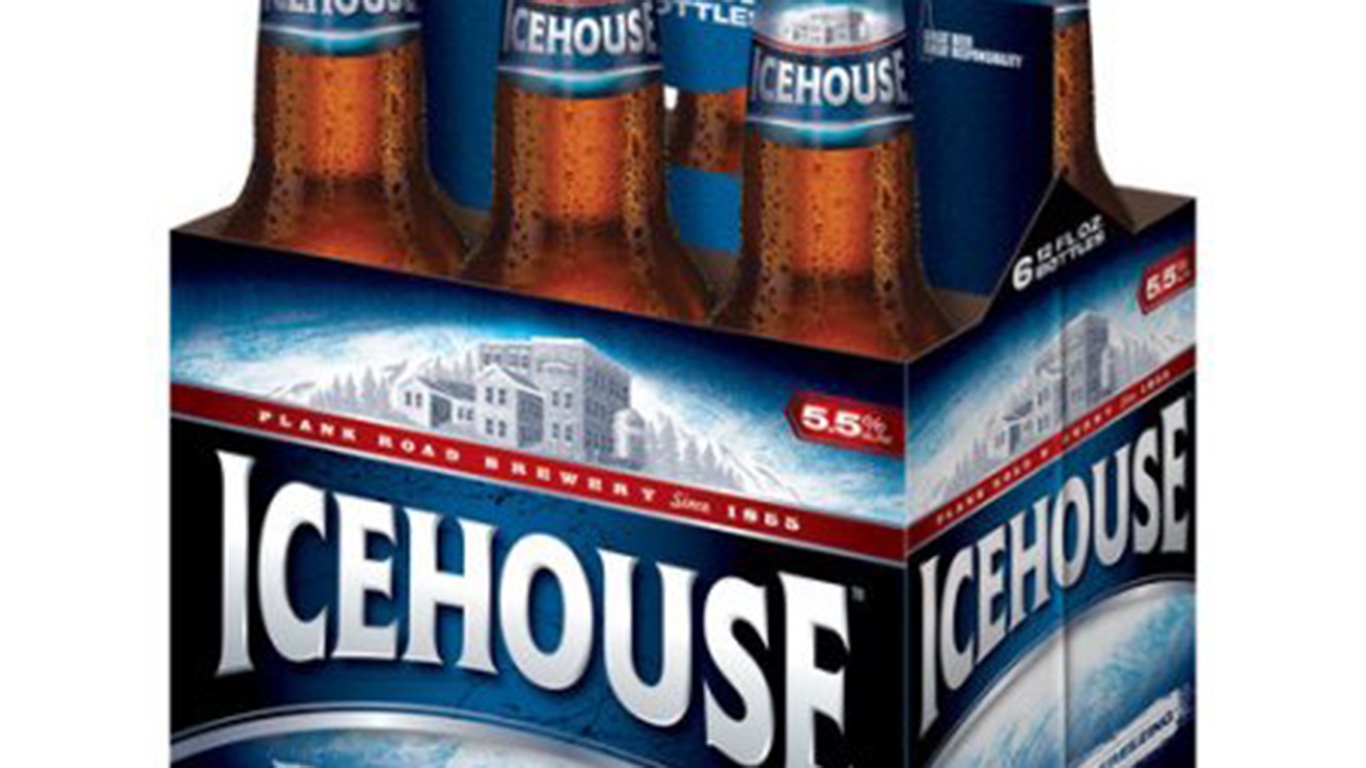
23. Icehouse
> Parent company: MillerCoors
> Barrels shipped in 2018: 1,280,000
> Change from 2013: -12.0%
> 2018 market share: 0.6%
This ice beer was the first one produced in America, making its debut in 1993. It comes in at 5.5% alcohol by volume.
[in-text-ad-2]

22. Coors Banquet
> Parent company: MillerCoors
> Barrels shipped in 2018: 1,550,000
> Change from 2013: 10.7%
> 2018 market share: 0.8%
Still brewed in Colorado, where it began, Coors Banquet is said to have been named in honor of the hearty feasts local miners ate when their workday was over.
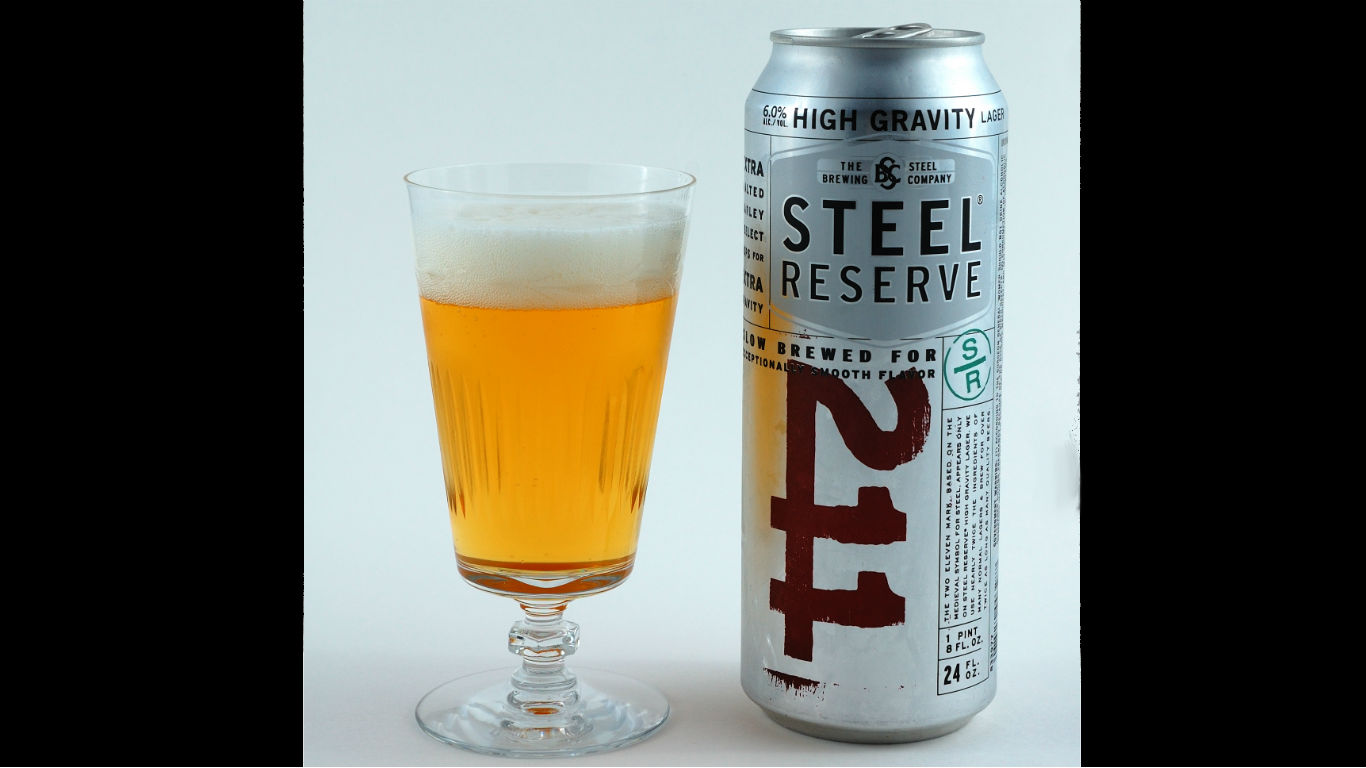
21. Steel Reserve
> Parent company: MillerCoors
> Barrels shipped in 2018: 1,585,000
> Change from 2013: 7.5%
> 2018 market share: 0.8%
Classified as a malt liquor — meaning that it’s higher than usual in alcohol (and also a little sweeter) — this hearty brew measures 8.1% ABV.
[in-text-ad]
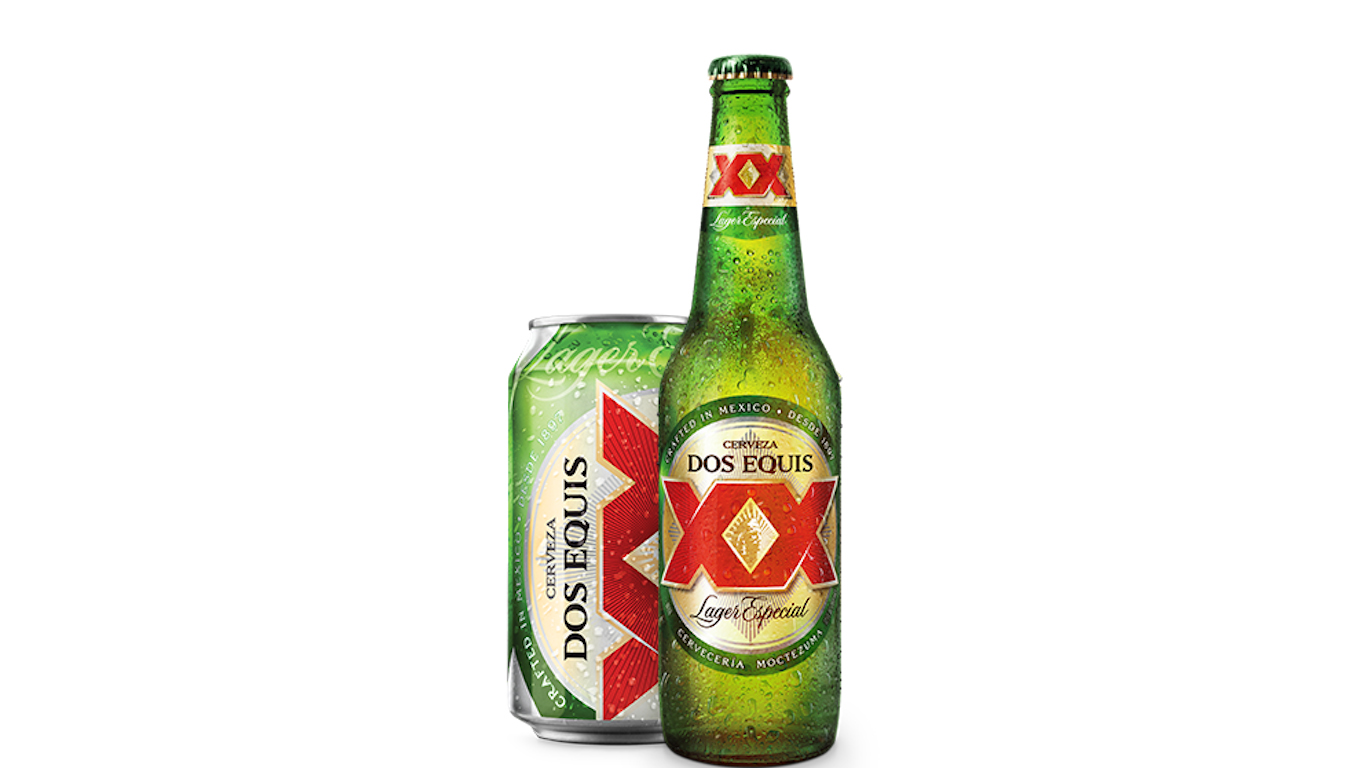
20. Dos Equis
> Parent company: Grupo Modelo (Heineken International)
> Barrels shipped in 2018: 1,900,000
> Change from 2013: 21.0%
> 2018 market share: 0.9%
Created in Veracruz in the 19th century by a German brewmaster, this emblematic Mexican brand was named “two x’s,” meaning 20 in Roman numerals — in honor of the then-forthcoming 20th century. The beer is not just one of the best selling in America, but also one of the fastest growing on this list.

19. Blue Moon (all)
> Parent company: MillerCoors
> Barrels shipped in 2018: 2,055,000
> Change from 2013: 1.5%
> 2018 market share: 1.0%
Blue Moon is a potent (5.4% ABV) Belgian-style white beer. Though it was created by a Coors brewer and is owned by the massive MillerCoors company today, it calls itself America’s No. 1 craft beer, citing Nielsen data to back up its claim. The Brewers Association has objected to its so-called craft identification.
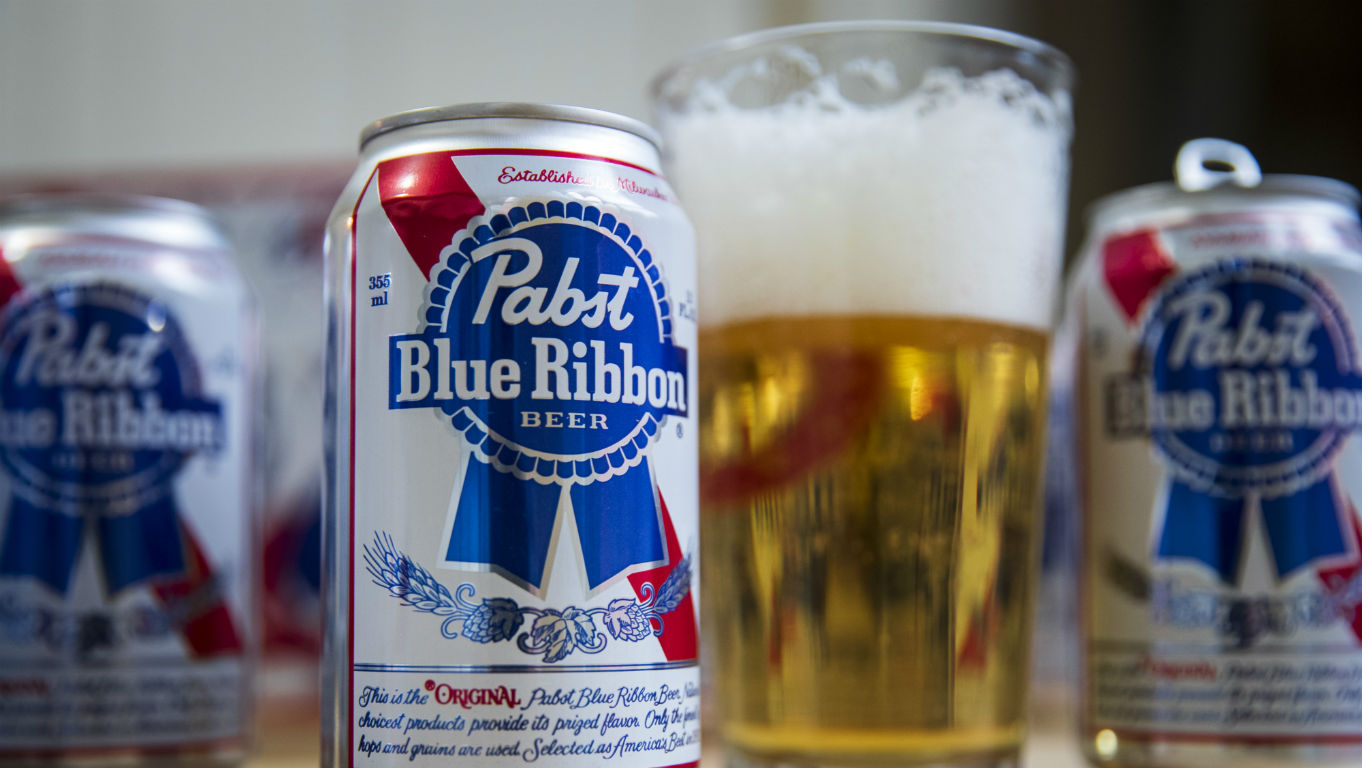
18. Pabst Blue Ribbon
> Parent company: Pabst Brewing Company
> Barrels shipped in 2018: 2,235,000
> Change from 2013: -14.2%
> 2018 market share: 1.1%
Brewed, though not owned, by MillerCoors, PBR is the definitive hipster beer, inexpensive and easily drinkable, and considered unpretentious in its familiar old-style cans.
[in-text-ad-2]

17. Yuengling Lager
> Parent company: D.G. Yuengling & Son
> Barrels shipped in 2018: 2,275,000
> Change from 2013: 4.4%
> 2018 market share: 1.1%
This Pennsylvania-based brewery is the oldest in America and one of the few major U.S. beer producers that is still family owned. Its sales numbers are particularly impressive considering that it is distributed only on the East Coast and in the South.
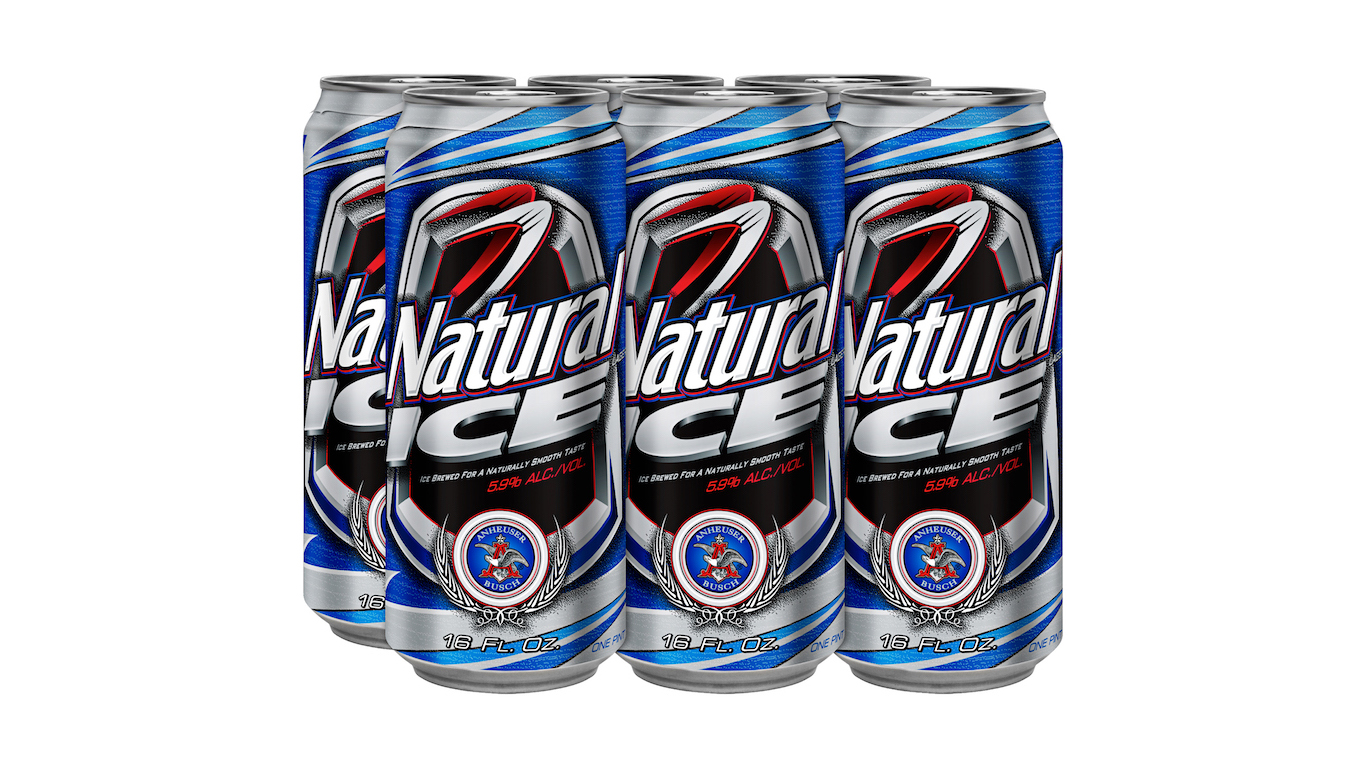
16. Natural Ice
> Parent company: Anheuser-Busch InBev
> Barrels shipped in 2018: 2,300,000
> Change from 2013: -20.0%
> 2018 market share: 1.1%
“Natty” — Natural Light — is currently the eighth biggest beer brand in America, but though its ice-beer sibling has lost some traction in recent years, it’s still very popular, too. Like most ice beers, it’s slightly more alcoholic than its conventional counterpart, at 5.9% ABV.
[in-text-ad]

15. Bud Ice
> Parent company: Anheuser-Busch InBev
> Barrels shipped in 2018: 2,500,000
> Change from 2013: 17.6%
> 2018 market share: 1.2%
While not known for an abundance of personality, this smooth, ice-brewed beer is gaining popularity, with shipments growing over 17% since 2013. With an ABV of 5.5%, it has only 123 calories per 12-ounce bottle, slightly lower than the usual.
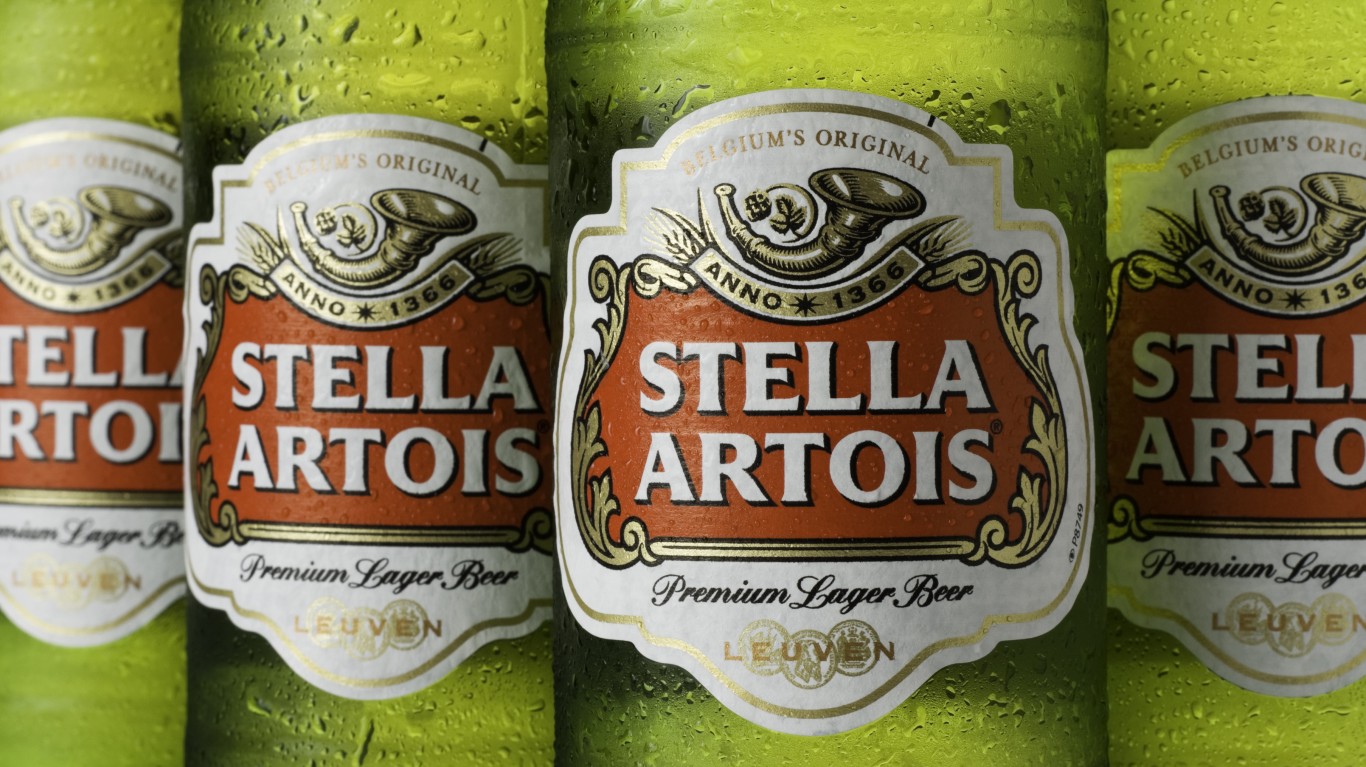
14. Stella Artois
> Parent company: Anheuser-Busch InBev
> Barrels shipped in 2018: 2,675,000
> Change from 2013: 67.2%
> 2018 market share: 1.3%
This classic Belgian lager was the third-fastest growing beer brand in America, among the top-sellers, between 2013 and 2018.

13. Miller High Life
> Parent company: MillerCoors
> Barrels shipped in 2018: 3,400,000
> Change from 2013: -14.5%
> 2018 market share: 1.7%
This pilsner-style beer, dating from 1903, was one of the first major bottled beers, though it is now commonly sold in cans as well. Brewer Frederick Miller dubbed it “The Champagne of Beers,” as a reference to its supposed luxurious quality.
[in-text-ad-2]
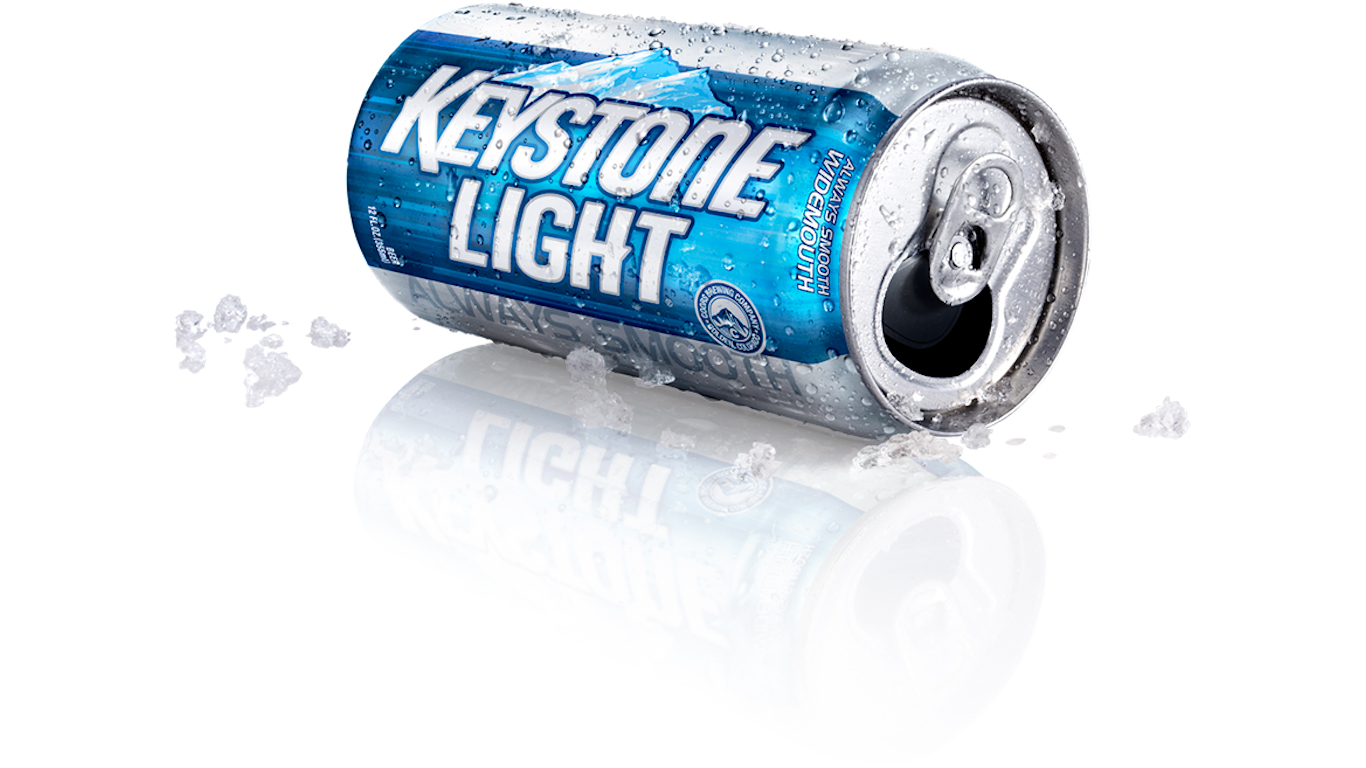
12. Keystone Light
> Parent company: MillerCoors
> Barrels shipped in 2018: 3,530,000
> Change from 2013: -10.4%
> 2018 market share: 1.7%
This triple-filtered light lager, brewed by Coors in Colorado, has only 101 calories per 12 ounces.
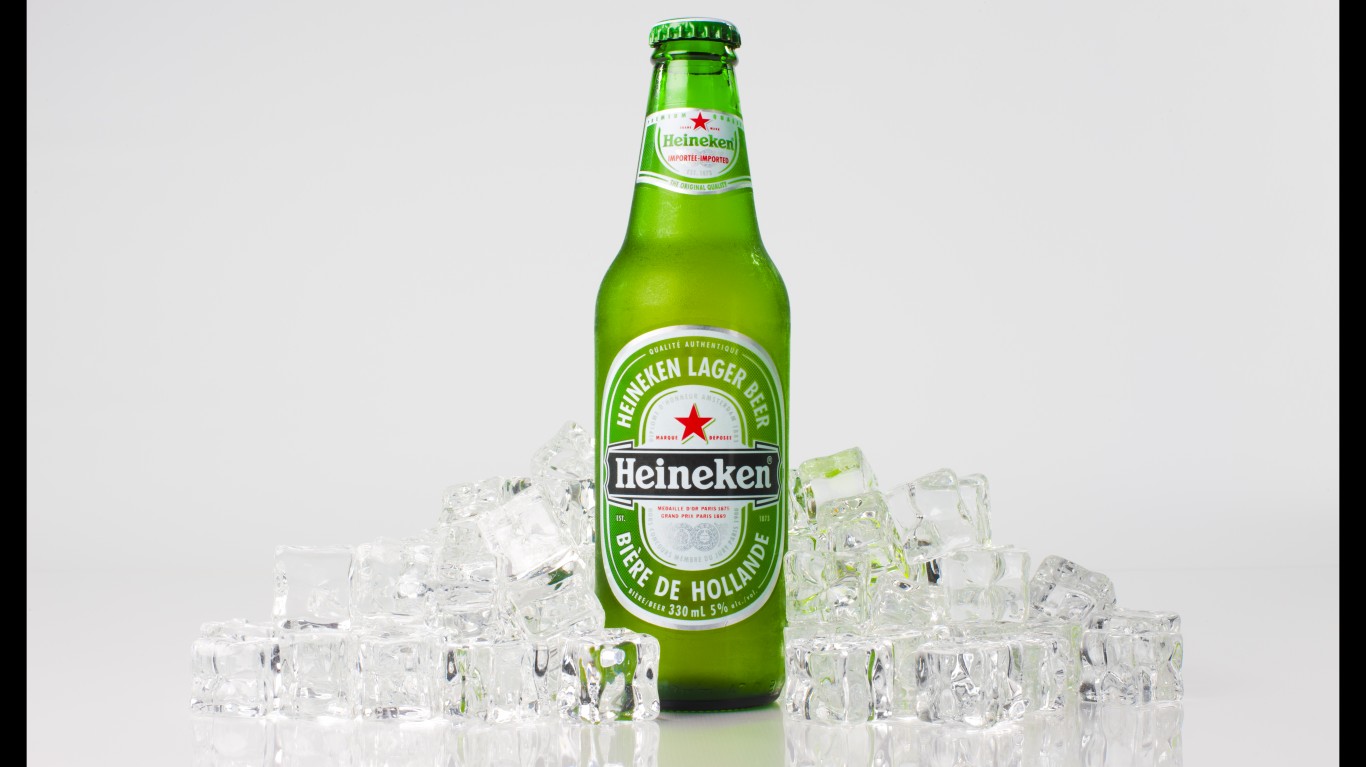
11. Heineken
> Parent company: Heineken International
> Barrels shipped in 2018: 3,800,000
> Change from 2013: -5.4%
> 2018 market share: 1.8%
Brewed in the Netherlands for more than 150 years, Heineken is one of the most recognizable and widely distributed beer brands around the globe — and it remains one of the world’s most popular lagers.
[in-text-ad]
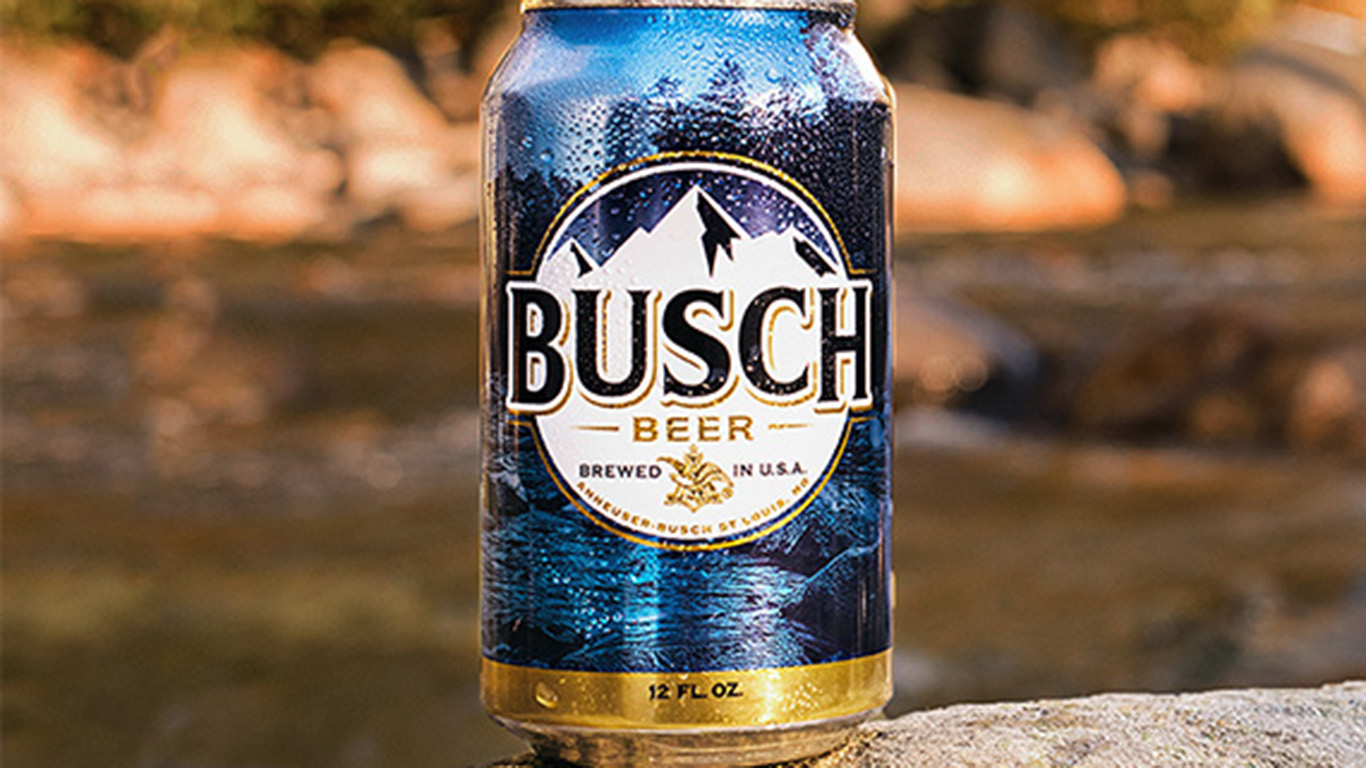
10. Busch
> Parent company: Anheuser-Busch InBev
> Barrels shipped in 2018: 4,175,000
> Change from 2013: -21.6%
> 2018 market share: 2.0%
Originally known as Busch Bavarian Beer, this was the first beer introduced by Anheuser-Busch after Prohibition (a long time after Prohibition — 1955, while anti-alcohol legislation was repealed in 1933). The snowy mountains on the can echo the brand’s claim to be “as crisp and cold as a mountain stream.”
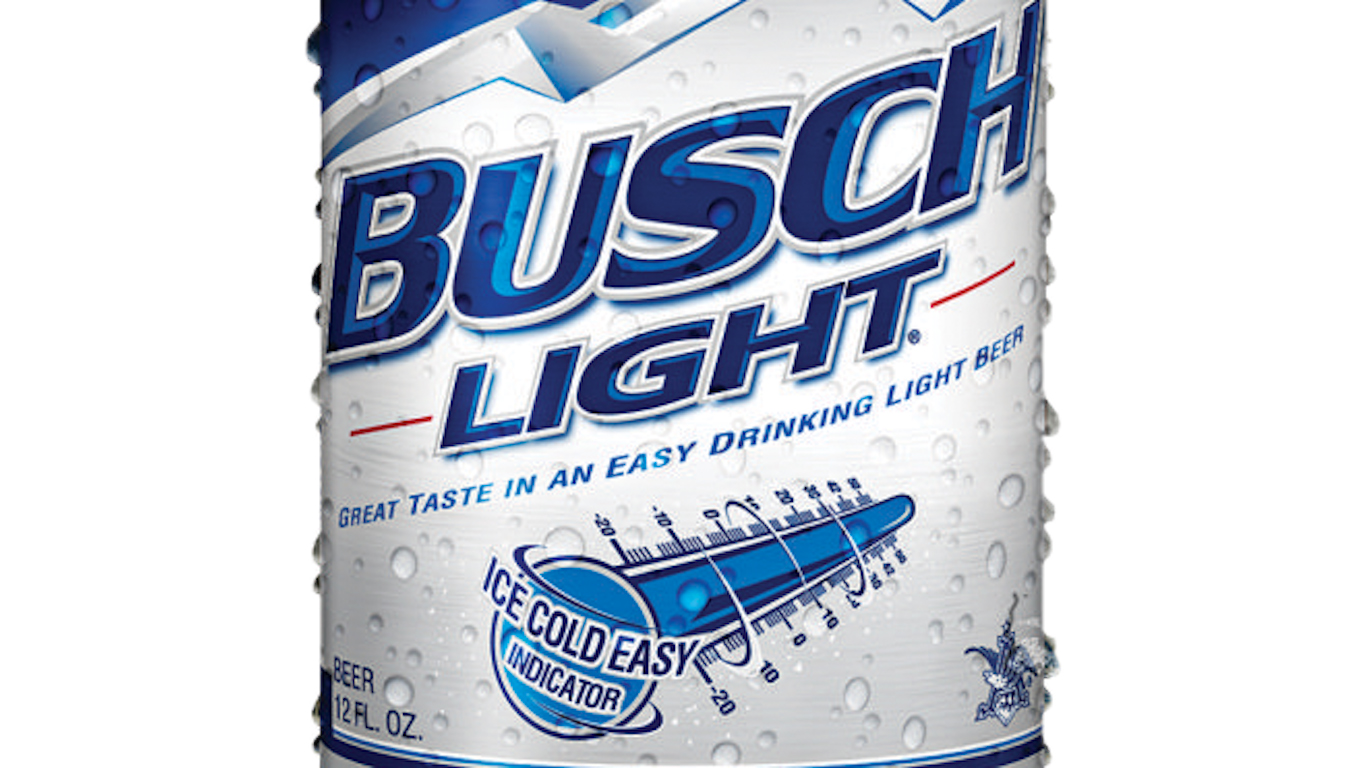
9. Busch Light
> Parent company: Anheuser-Busch InBev
> Barrels shipped in 2018: 6,200,000
> Change from 2013: -3.9%
> 2018 market share: 3.0%
This lighter sibling to the original Busch has slightly less alcohol (4.1% versus 4.3%), but earns its “light” designation with 95 calories per 12-ounce can (nine fewer than Busch) and 3.2 grams of carbohydrates, roughly half what its near-namesake has.

8. Natural Light
> Parent company: Anheuser-Busch InBev
> Barrels shipped in 2018: 6,700,000
> Change from 2013: -11.8%
> 2018 market share: 3.3%
“Natty” bills itself as “the official beer of keeping it real and letting things just happen.” A reduced-calorie light pilsner, it has the same calorie and carb count as another Anheuser-Busch light brand, Busch Light — 95 and 3.2, respectively.
[in-text-ad-2]

7. Modelo Especial
> Parent company: Grupo Modelo (Constellation Brands)
> Barrels shipped in 2018: 8,180,000
> Change from 2013: 121.4%
> 2018 market share: 4.0%
The second most popular Mexican beer for American drinkers, Modelo Especial is a rich pilsner-style lager. (It has a darker, richer Munich Dunkel-style lager cousin, Negra Modelo, with a following of its own, though its sales are substantially lower.)
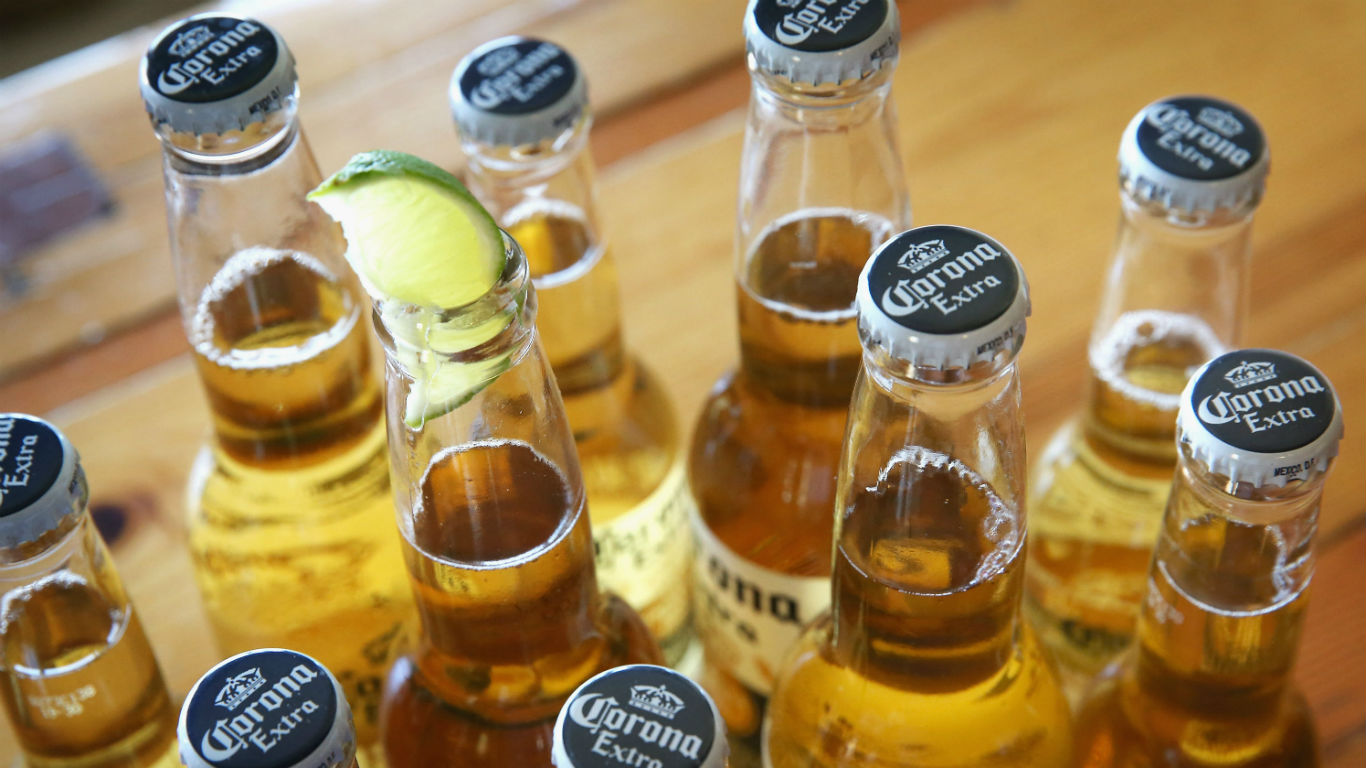
6. Corona Extra
> Parent company: Grupo Modelo (Constellation Brands)
> Barrels shipped in 2018: 8,580,000
> Change from 2013: 20.8%
> 2018 market share: 4.2%
America’s favorite Mexican beer, and the nation’s No. 1 imported beer, Corona was first crafted in 1925 but didn’t make its appearance stateside until 1981. Like Tecate, it is often quaffed with a squeeze of lime juice — and in 2018, the Earth Source produce company made a deal to market Corona Extra-branded limes.
[in-text-ad]
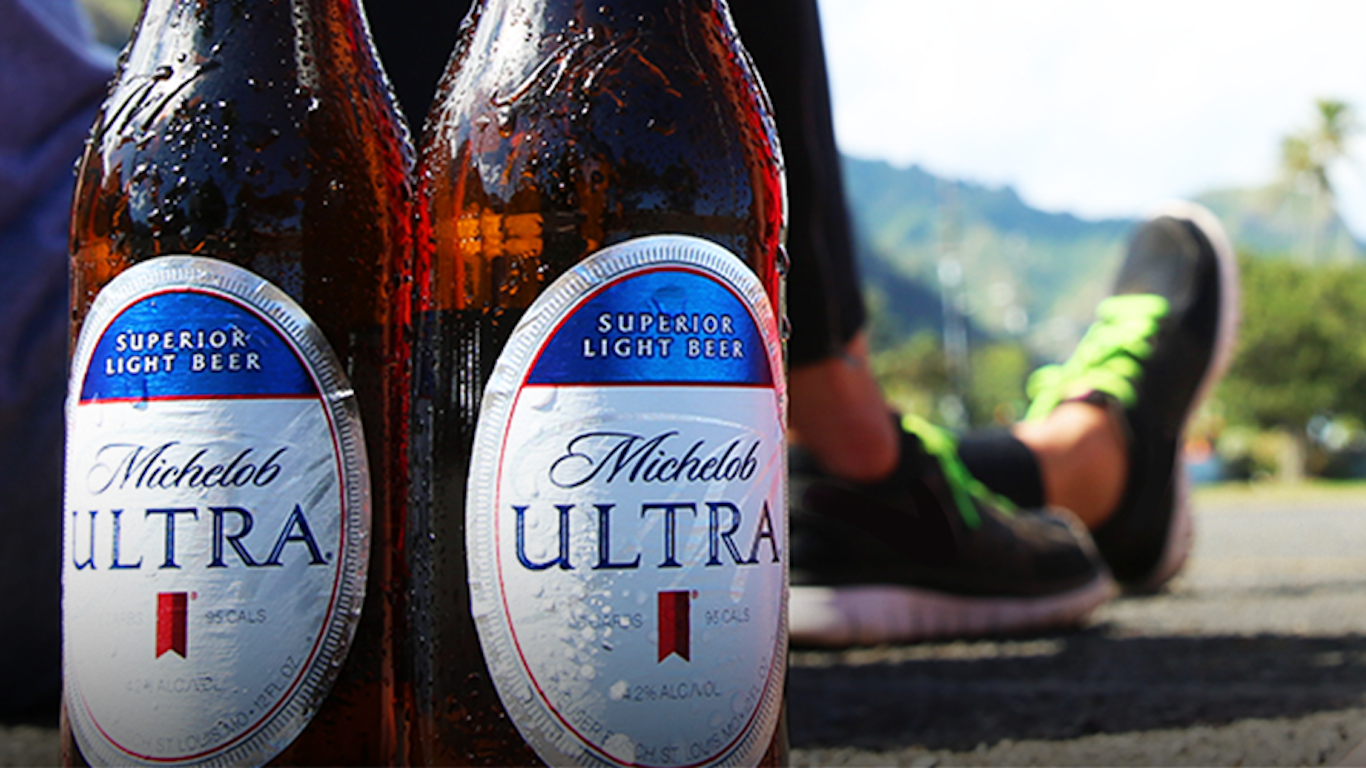
5. Michelob Ultra
> Parent company: Anheuser-Busch InBev
> Barrels shipped in 2018: 8,800,000
> Change from 2013: 114.6%
> 2018 market share: 4.3%
This light beer is a brew of choice for drinkers on a low-carb diet, with only 2.6 grams of carbohydrates per 12-ounce bottle, making it the fifth lowest on the market and the only one with sales sufficient to qualify for this list.

4. Budweiser
> Parent company: Anheuser-Busch InBev
> Barrels shipped in 2018: 11,300,000
> Change from 2013: -25.2%
> 2018 market share: 5.5%
Bud is the best selling beer in America that isn’t a light (or “lite”) offering. It’s brewed with a process called kraeusening, which means it is carbonated with actively fermenting beer, which helps remove off-flavors and shortens carbonation time. During kraeusening, treated beechwood strips are added to the beer to collect yeast and increase its contact with the beer — Bud’s famous “beechwood again.”

3. Miller Lite
> Parent company: MillerCoors
> Barrels shipped in 2018: 12,575,000
> Change from 2013: -7.9%
> 2018 market share: 6.1%
Miller calls this brew “the original light beer” — but it isn’t really. Reduced-calorie beer was invented by a chemist for the Rheingold Brewing Company in 1967 and sold under a couple of different brand names until 1972, when Miller bought it, reformulated it, and released it as Miller Lite in 1975. The brand’s iconic “Tastes great!” / “Less filling!” TV campaign, featuring retired sports figures and other celebrities, is credited with helping popularize the beer.
[in-text-ad-2]
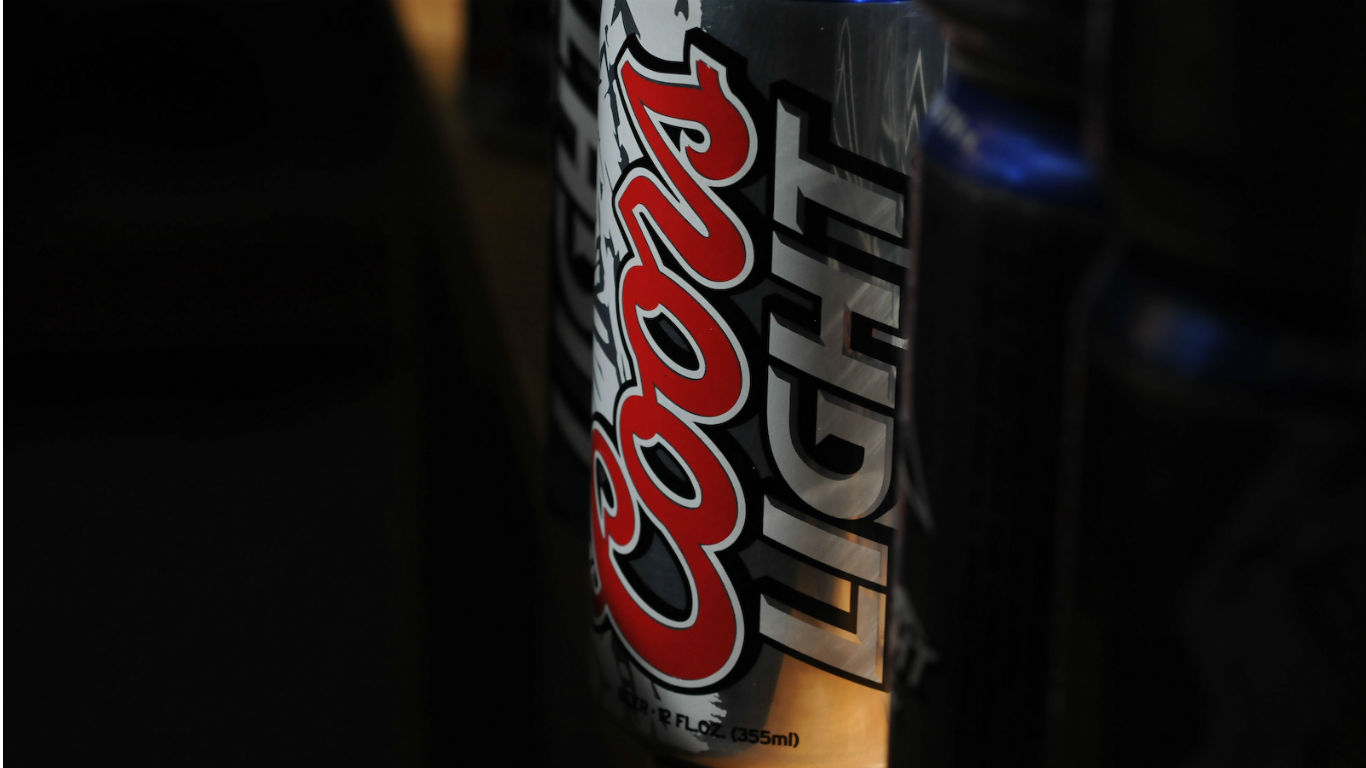
2. Coors Light
> Parent company: MillerCoors
> Barrels shipped in 2018: 14,875,000
> Change from 2013: -14.9%
> 2018 market share: 7.2%
This low-cal, low-carb lager doesn’t do much for beer reviewers but appeals to many drinkers for its light, clean flavor, and the ease with which it goes down. It doesn’t do that well as a diet beer, by the way: There are at least a dozen other beers with fewer carbs, and at least 14 of its competitors have fewer calories.
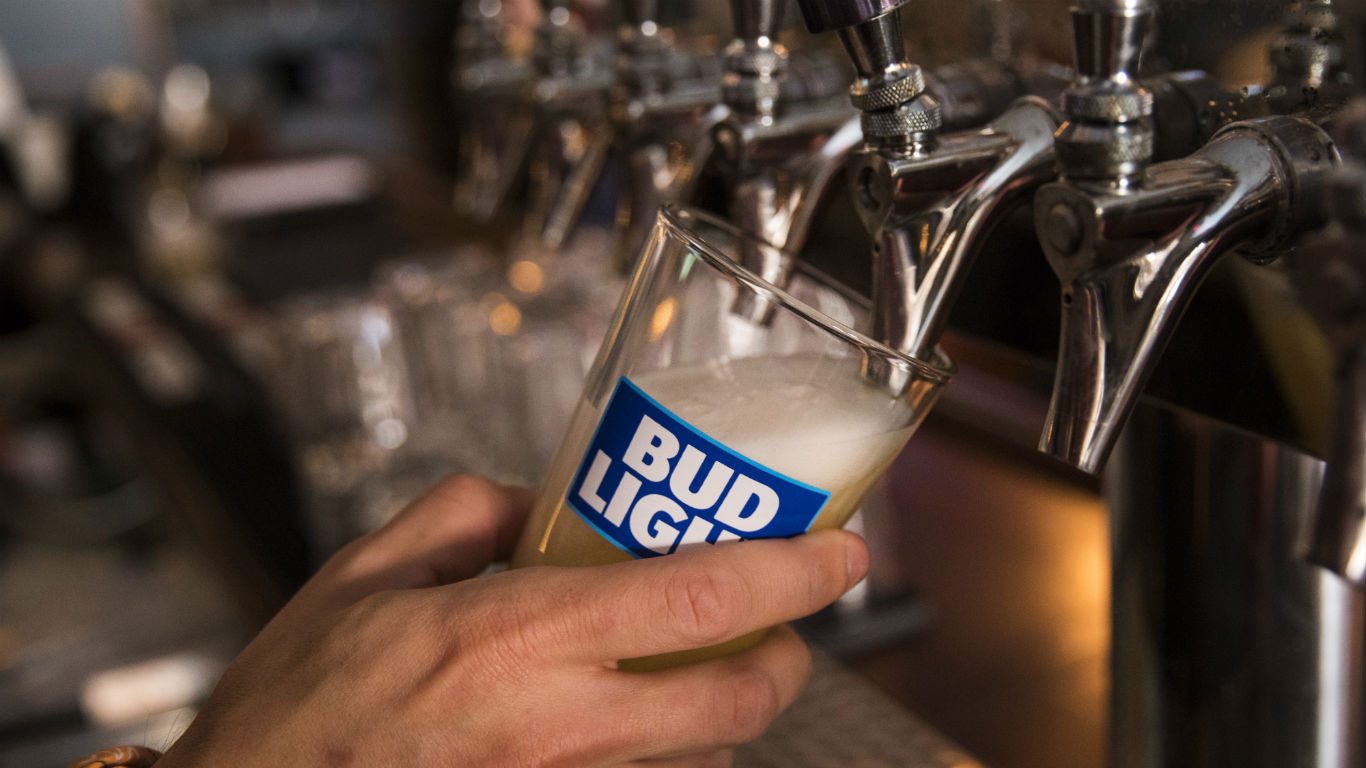
1. Bud Light
> Parent company: Anheuser-Busch InBev
> Barrels shipped in 2018: 29,350,000
> Change from 2013: -20.7%
> 2018 market share: 14.3%
Its sales might be down by over 20% since 2013, but Bud Light is still America’s favorite beer by a two-to-one margin. The fact that it earns an overall score of zero from RateBeer and a 1.86 “Awful” rating from BeerAdvocate obviously doesn’t deter fans. The brand may have suffered a brief downturn after Super Bowl Sunday this year, with its ads bragging that — unlike light beers from Miller and Coors — it doesn’t use corn syrup to sweeten its beer. Some corn farmers reportedly responded by pouring cans of Bud Light down the drain.
100 Million Americans Are Missing This Crucial Retirement Tool
The thought of burdening your family with a financial disaster is most Americans’ nightmare. However, recent studies show that over 100 million Americans still don’t have proper life insurance in the event they pass away.
Life insurance can bring peace of mind – ensuring your loved ones are safeguarded against unforeseen expenses and debts. With premiums often lower than expected and a variety of plans tailored to different life stages and health conditions, securing a policy is more accessible than ever.
A quick, no-obligation quote can provide valuable insight into what’s available and what might best suit your family’s needs. Life insurance is a simple step you can take today to help secure peace of mind for your loved ones tomorrow.
Click here to learn how to get a quote in just a few minutes.
Thank you for reading! Have some feedback for us?
Contact the 24/7 Wall St. editorial team.
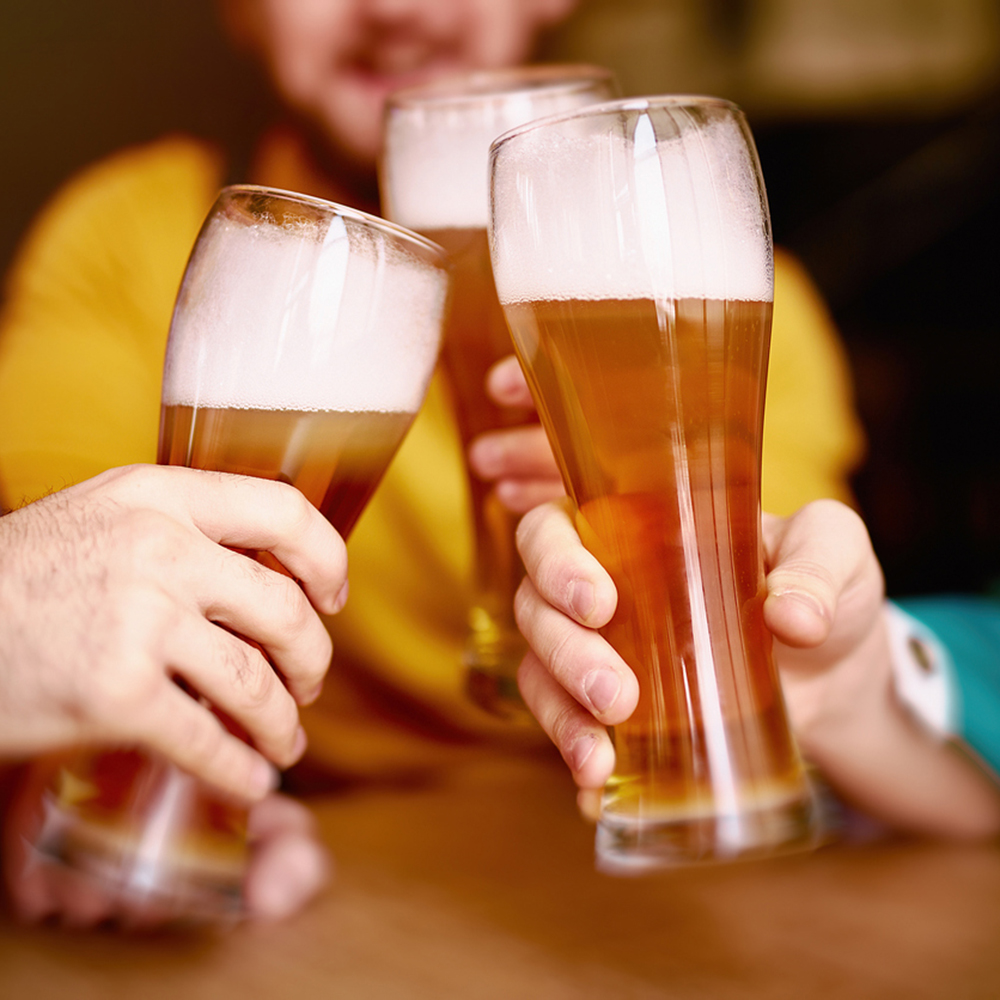 24/7 Wall St.
24/7 Wall St.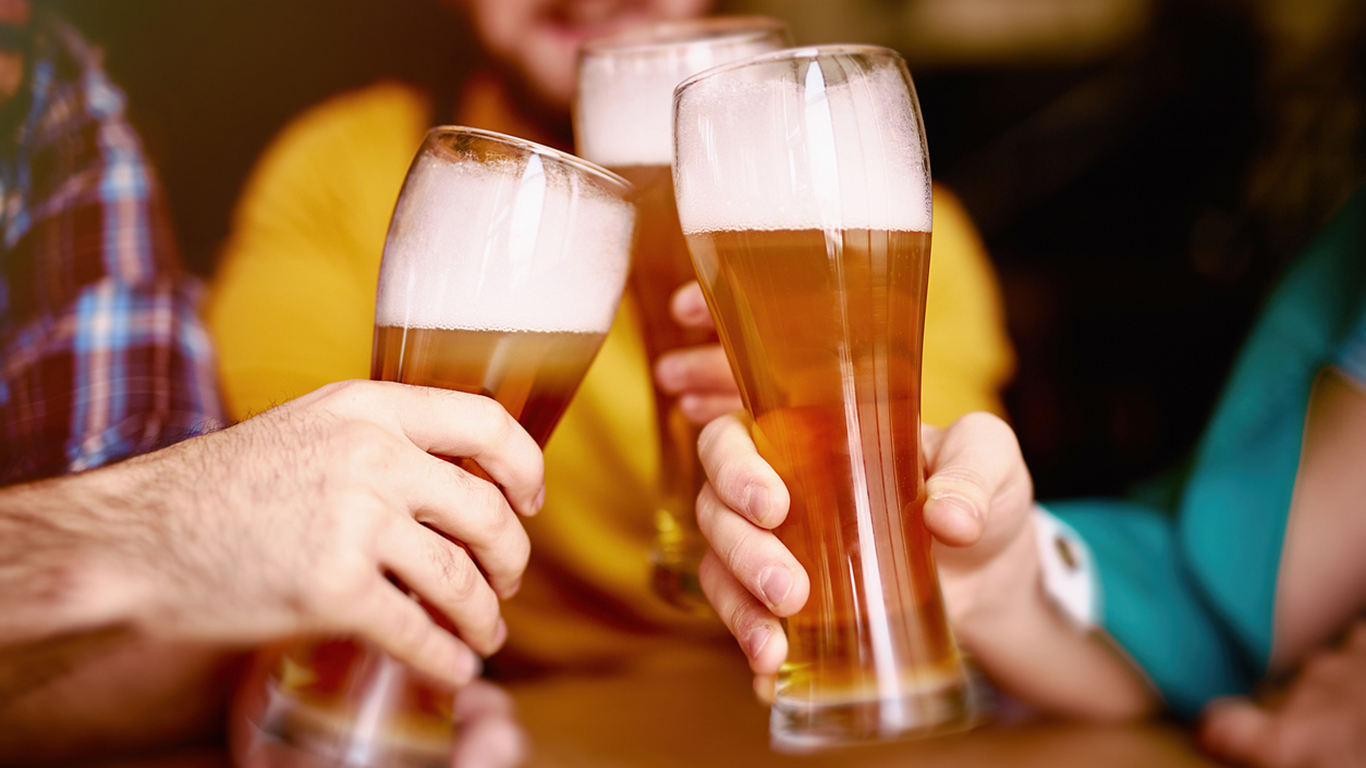 24/7 Wall St.
24/7 Wall St. 24/7 Wall St.
24/7 Wall St. 24/7 Wall St.
24/7 Wall St. 24/7 Wall St.
24/7 Wall St.

